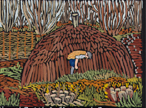Throughout history, plants
have provided us with food and medicines. Nowadays we can easily
forget that, until recently, locally-growing plants also provided
all the raw materials for survival - shelter, clothing, fuel,
tools, even transport. Luxuries too - dyes to make clothes colourful,
perfumes, wines, musical instruments, a gift of flowers. Our
civilization sprang from the intelligent use of the plants around
us.
From here you can see many
species of tree. Each has specific uses, which our ancestors
knew well. For instance, oak is heavy and rigid, ideal for housebuilding.
Ash is light and flexible, perfect for horse-drawn machinery.
Beech is versatile - clog-soles, furniture, beech-nuts for
fattening pigs. Smaller trees, like elder
or damson, produced wood for carving spoons, or cog wheels, or
tool-handles. Their fruits still give pleasure. First, pick your
berries, then make your wine and jam!
 Stacking wood
for a charcoal burn Stacking wood
for a charcoal burn
This landscape once had much more woodland. Hazel coppice,
cut and grown back every 15 years, gave an endlessly renewable
source of firewood, plus charcoal (essential for metal working),
hurdles for fencing and building ("wattle and daub")
and nuts. Birch, willow, alder, holly, hawthorn, and the sadly
vanished elms - each had its role in the technology of survival,
and each provided employment for highly skilled specialists.
Once, almost everybody had a craft which made them vital to the
local economy.
|
Spot the history
in local plants

Oak spokes, ash felloes, elm nave- the recipe for a wheel.
From an etching of 1910.
Ancient technology
from natural resources 
Bee-skeps made from straw rope - from a 12th. century psalter
|
Smaller plants were also vital. Besides
being the only medicines and flavourings, their pollen made honey,
the only sweetener. And honey made beer, which everyone drank
in pre-tea times. Uses were found for almost every plant.
For instance, teasels were (& still are) used to finish woollen
cloth; bluebells made glue; horsetail scrubbed and polished metal;
butterbur leaves wrapped many things, including butter. Fungi
such as Ink Caps and Razorstrops were prized by scholars and
barbers.
Rushes made cheap candles, and disposable carpeting for flagstone
floors. Meadowsweet ("Daneswort") was the original
air-freshener. Strangely, Daneswort only grows in places where
Vikings settled. Nettles often indicate a vanished building.
Plants give many clues to our history. 
Gathering teasels- from an 18th. century aquatint
But the most important plant of all is the
grass. It turns rain and sun into food for
cattle and sheep - which give us meat, milk, leather and wool.
A protein-rich diet and warm clothing are vital in this climate!
Horse-power for farm-work and transport was also fuelled by grass.
In winter, it's hay. Year round, its roots hold the earth together,
stopping wind erosion. The moorland all around us has changed
very little over the centuries, still growing the rough pasture
grasses called "bents". Proving how important the grass
was, and still is, to life around here, Bentham takes its name
from it.
|